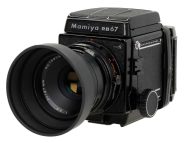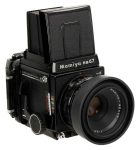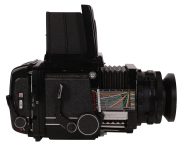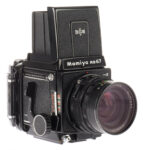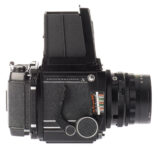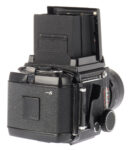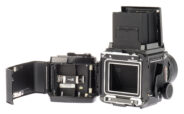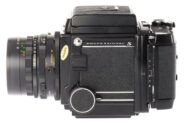Mamiya RB67 Professional S
Medium format MF film SLR camera
Specification
| Production details: | |
| Announced: | 1974 |
| System: | ● Mamiya RB67 (1970) |
| Format: | |
| Maximum format: | Medium format 6x7 |
| Film type: | 120 roll film |
| 220 roll film | |
| Mount and Flange focal distance: | Mamiya RB67 [111mm] |
| Shutter: | |
| Type: | In-lens leaf shutter |
| Exposure: | |
| Exposure metering: | None |
| Exposure modes: | Manual |
| Physical characteristics: | |
| Weight: | 2705g |
| Dimensions: | 144x104x228mm |
Manufacturer description #1
The modern photographer requires a camera that is suitable for any field, be it commercial, sports, industrial or scientific. The Mamiya RB67 PRO-S is ideal, first of all, because of its proportionally desirable 6 x 7 format. Then there are the systems of interchangeable accessories: the lenses, from 37mm wideangle to 500mm telephoto; a complete range of film backs for every conceivable type of film available on the market today; and interchangeable viewfinders and focusing screens to help the photographer see to best advantage what he is photographing. Flexibility is added by the revolving backs, allowing either horizontal or vertical format to permit the desired composition with a maximum of speed and a minimum of inconvenience.
The entire system is backed up by famous Mamiya technology and attention to detail. For example, the new multi-coating of the lenses, the rack-and-pinion bellows mechanism. And the new safety features to prevent wasted film and lost shots. Whatever his field, the modern photographer will find his dream camera in the Mamiya RB67 PRO-S.
This brilliant combination of the large 6 x 7 format with the parallax-free SLR system gives unsurpassed ease of focusing and exact framing for both horizontally and vertically framed shots. Red lines on the focusing screen indicate the picture area for horizontal compositions. When the back is rotated for vertical compositions these red lines disappear and picture limits are shown by dotted lines. You see exactly the area that will appear on the negative, even for extreme closeups. You get maximum use of the entire film area.
The single-action focusing hood of the PRO-S enhances the fast focusing and framing for which SLRs are famous. A new design allows the focusing hood to be collapsed or erected with a simple motion of one hand. And the finder screen is entirely screened from extraneous light when the magnifier is in position, eliminating troublesome glare and reflections. Magnifiers are available in various diopters to suit individual vision.
This lock allows the photographer to lock the focusing mechanism in place after adjusting the focus. A feature useful in any type of photography but especially in close-up work to prevent slips with the very critical depths of field that occur.
The only 6 x 7 format camera in the world with the revolving back, the Mamiya RB67 PRO-S boasts a complete system of interchangeable backs to meet every need of the discriminating and creative photographer. Any type of film can be used: color, black and white, or even Polariod films, merely by swiftly changing the back. Those who own other Mamiya cameras with film holders can use these without alteration. Four types of locks are available for attaching various adapters and film holders. Another Mamiya first.
With its smooth operating rack-and-pinion bellows the Mamiya RB67 PRO-S can be used for close-up photography with or without attachments . A full 46mm extension allows focusing to as close as 3.9cm lens-to-subject with the 50mm wideangle lens. Exposure corrections are made simple by the table on the camera body for all lenses and bellows extensions. With the auto- extension tubes even macrophotography is possible. A whole new world of photography made easy for professional or amateur.
A new multi-coating process has made the Mamiya-Sekor lenses among the sharpest in the world. Not only are images focused to perfection but the old problem of reflection has been overcome. Single-coated lenses can prevent reflection within the lens in only certain frequencies. Multi-coating overcomes this handicap and eliminates reflection over a wide range of frequencies, making images clearer and tones crystal clear as never before. In color work this is especially valuable as color rendition is vastly improved. Another asset is the prevention of ghosts which occur is complex lenses; this is possible only through multi-coating. A simple new way for you to get more out of photography.
Conditions of ten change in photography requiring a different focusing screen. Mamiya has available a selection of five of these screens to meet conditions encountered in all branches of photography. All of these screens have broken black lines for horizontal and solid lines for vertical framing. And included are the Standard Matte, which is standard equipment; the Checker, with grid markings; Rangefinder Spot, with a split-image prism; Microprism for quick focusing; and Cross Hair for high magnification close-up photography.
Manufacturer description #2
REVOLVING BACK
The back of the Mamiya RB67 Pro-S can be turned 90° in one direction and has a positive lock to insure proper alignment of double- exposure preventive system and alignment with finder. This allows the picture format to be changed from horizontal to vertical without changing the camera's position or removing it from the tripod. To help in composing the picture, red lines appear on the focusing screen to indicate when the horizontal format is being used.
This kind of mechanism is considered standard on a 4 x 5 inch (9 x 12 cm) format view camera. However, the Mamiya RB67 Pro-S is the first 6 x 7 cm camera to be equipped with it, putting it on a technical par with the view camera.
Since 35mm cameras are relatively small, changes from horizontal to vertical format and vice-versa are done by changing the position of the camera itself. With medium-format cameras, however, this puts quite a strain on the cameraman. Consequently, for many years 6 x 6 cm format cameras were used, despite the fact that the photographer later had to resort to wasteful cropping of the image. The advantage of the 6 x 6 cm format, of course, was the fact that there was no need to change the camera position to take horizontal or vertical photographs since the sides of the picture were all the same length.
FORMAT
The 6 x 7 cm format is a logical picture size which evolved after careful consideration of the pros and cons of other picture sizes.
The Mamiya RB67 Pro-S provides an actual picture size of 56mm x 68mm, with a width/length ratio of 1:1.2. This ratio is very similar to that of view cameras like the 4 x 5. People who are accustomed to such cameras will have no problem adjusting to the RB67 Pro-S film format.
Moreover, this length/width ratio is also very close to the ratios of most standard sizes of photographic paper, which means that the picture framed in the single lens reflex viewfinder can be printed exactly as it is seen in the viewfinder without cropping.
This format is also logical in terms of the number of photographs per roll. A 6 x 9 cm format camera can make onIy 8 exposures on 120 roll film. And while a 6 x 6 cm format camera can make 12 exposures, they must all be cropped to the paper size, making the effective part of the picture similar to that of a half-format. With the 6 x 7 cm format, however, 10 pictures can be taken, with an effective picture size similar to the older 6 x 9 cm format.
Today, the 120 size is not the only roll film available. There is a tendency towards longer films, with a 220 size (20 exposures) and a 70mm (50 exposures) on a 15 foot roll. Medium-format cameras are gradually acquiring the same number of frames per roll capabilities as the 35mm camera.
It is possible to change holders in mid-roll, and an interlock system is utilized to avoid mistakes when interchanging. The Polaroid® Land pack film holder also permits the use of instant films. The format changes to 7 x 7 cm but since it is roughly similar to the format of Polaroid ® type 80 pack films, image size loss is reduced to a minimum.
THE BELLOWS
With the Mamiya RB67 Pro-S, focusing is accomplished with a bellows extension system, rather than a helicoid lens extension system. Not only does this system produce a clear picture with little internal light reflection, it also makes the Mamiya RB67 Pro-S a good camera for close-ups. This enables it to be used for product photographs, a task that was formerly achieved only with a much larger view camera.
The bellows can be extended 46mm. With a 90mm f/3.8 lens, close-ups with a magnification of about 1/2x, (1/2 life- size) can be taken. Using a 127mm f/3.8 lens, a magnification of about 1/3x can be achieved.
The RB67 Pro-S has a unique distance scale graph on the side of the bellows which displays the curves of all the various focal length lenses. This feature makes it possible to easily read photographic distances graphically on the camera itself. It also shows precisely how many millimeters the bellows has been extended as well as exposure compensation factors for close-ups with each lens.
For larger magnification close-up photography, exclusive Auto Extension Tubes are available for the Mamiya RB 67 Pro-S. Extension Tube No. 1 is 45mm long and No. 2 is 82mm.
If you add the 45mm of the Auto Extension Tube No. 1 to the length of the bellows fully extended, it adds up to 91mm.
Using the No.1 Tube with a 90mm f/3.8 lens it is possible to take life-size close-up photographs in a 1:1 ratio. The Auto Extension Tube No.2, used together with the fully extended bellows and a 127mm f/3.8 lens, also makes it possible to take life-size close-ups. In addition, by varying combinations of lenses and extension tubes, and by varying the extended length of the bellows, it is possible to change lengths continuously from 0 - 173mm, with some overlap. What this means is that with a 90mm f/3.8 lens you can take a close-up with a magnification of 2x (of a photographic subject area 30 x 36mm) while a 180mm lens allows telescopic close-ups of the subject in almost its actual size.
Proper exposure is essential for obtaining sharp close-ups. For this reason, interchangeable viewfinders with built-in TTL metering systems are available for the RB67 Pro-S. The CdS Magnifying Hood Finder, in particular, provides excellent spot metering through a 6mm diameter spot in the middle of the picture, which helps assure correct exposures.
We are confident that the Mamiya RB67 Pro-S camera and lens system will produce excellent close-up photographs because of the large 6 x 7 cm image size and the optics that are believed to be superior to others in the field.
Manufacturer description #3
Designed with the professional in mind, this fine camera system provides the ultimate in quality, versatility, and photographic excellence. The superb precision and innovative features help to make the RB67 Pro-S the practical system for serious photographers. The ideal 6x7cm format is proportioned to the most common print sizes. The unique revolving back system, which accepts a multitude of film holders and adapters, provides convenience and efficiency. A fully interchangeable system of lenses with built-in shutters, viewfinders and screens for every application, and other accessories help to make the RB67 Pro-S the working photographer's dream.
- SINGLE-ACTION FOCUSING HOOD opens and closes with a touch. Interchanges with magnifying hoods and prism finders, including types with built-in CdS metering systems (will fit original RB67).
- BREECH LOCK LENS MOUNT is designed for quick lens changing and secure locking. A safety device prevents the lens from being removed if the mirror is not cocked.
- BELLOWS FOCUSING SYSTEM permits smooth rack-and-pinion focusing and allows close-up work without special attachments. For ultra-close photography, automatic extension tubes are available.
- INTERCHANGEABLE LENS-SHUTTER COMBINATIONS give highest effeciency and matched performance, All shutters are identical with speeds from 1 to 1/400 second plus T and full flash synchronization at any speed. Lenses have multi-layer coatings, automatic diaphragms, depth-of-field scales, and common (77mm) filter threads.
- FILM ADVANCE LEVER is conveniently located on the 120 and 220 roll film holders. A single movement or multiple strokes of the lever quickly advances the film. The double exposure prevention system has an intentional override.
- UNIQUE REVOLVING.BACK system enables horizontal or vertical format photography without changing the camera positiofl. Red lines appear on the focusing screen to indicate when the back is set to the horizontal position.
- FILM HOLDERS include those for 120 and 220 rolls, film packs, cut film and plates, and Polaroid film packs. With appropriate adapters, film holders for the Mamiya press camera as may also be used.
- SHUTTER COCKING LEVER also cocks the mirror with a single quick motion. A safety device prevents the lens from being removed unless the mirror is down.
- INTERCHANGEABLE BACKS allow complete film-use flexibility. Any back or film holder may be removed in mid-roll without frame loss.
- FOCUSING KNOB is large and easy to use. Another focusing knob is on the opposite side of the camera for added convenience.
- SHUTTER RELEASE is conveniently located for efficient exposures. A locking ring prevents accidental exposure.
- LOCK LEVER for the focusing knob secures the focus setting once it is made and prevents accidental movement.
- 6x7cm FORMAT is considered ideal as the negative can be enlarged to 8x10 proportions with virtually no loss of picture area.
- INTERCHANGEABLE FOCUSING SCREENS provide the desired view for every type of photographic application. Five different screens are available.
PLUS: Film exposure counter. Film position indicator. Multiple exposure lever. Mirror release operating knob. Accessory shoe on camera body. Dark slide storing lug. Magnifier with interchangeable lenses. Distance scale for all lenses. Depth-of-field preview lever. Multiple safety interlocks and more!
Manufacturer description #4
The Mamiya RB67 Pro-S is a unique, high-grade, 6 x 7cm lens-shutter type, single-lens reflex camera developed to offer excellent picture quality and easy handling. Mamiya feels confident that the extensive versatility and capabilities of the Pro-S will meet and satisfy the requirements of all photographers.
1. Rational 6 x 7cm format
Since the 6 x 7cm format covers an area 4.5 times the 35mm format, excellent picture quality is obtainable. Especially, it demonstrates superb results in color photography. The ratio between the length and width of 6 x7cm formats is almost the same as that of large photographic paper, permitting economical enlargements without cropping.
When designing a magazine layout, a sufficient blank space is reserved for headlines and explanatory notes, so that the entire picture format can be fully utilized.
2. Single-lens reflex camera offering a bright, large finder image
Since parallax-free focusing in the outstanding feature of the single-lens reflex camera, speedy camera operation is possible through brilliant, precise 6 x 7cm picture composition.
3. Excellent Mamiya Sekor lenses
Mamiya Sekor lenses boast excellent image rendition and color balance. Various types ranging from wide-angle lenses to telephoto lenses are available.
These lenses are rationally grouped in series, whereby those exactly adaptable to one’s particular photographing objectives are optionally selectable with ease.
4. Lens-shutter system suitable for electronic flash photography
By adopting the lens-shutter system, electronic flash is synchronized with all shutter speeds, making it possible to produce highly impressive photographs.
5. Double-exposure prevention and multiexposure devices
An interlocking device for double-exposure prevention is incorporated in the Pro-S roll film holder. Since this device is interlocked with the Pro-S body mechanism, the shutter cannot be released unless the film is advanced. Also, film advance for the next exposure is impossible unless the shutter is released.
When the shutter is released, the film wind-stop is automatically released.
Multiple exposure photography is available simply by switching a lever.
6. Vertical or horizontal picture format quickly changed over with the revolving adapter
A revolving adapter is provided as a standard outfit, whereby the vertical or horizontal picture format is promptly selected by turning the camera body back by 90° without changing the camera position.
This is especially convenient when the camera is mounted on a tripod.
7. Finder format index interlocked with revolving adapter
When the revolving adapter is turned up to 90°, horizontal format picture index red lines appear (or disappear), presenting proper picture composition.
8. Excellent film flatness ensured by Pro-S roll film holder
Various tests have been applied to the Pro-S roll film holder to stabilize film flatness. As a result, film flatness has been further improved.
9. Camera back adapter changeable according to photographing objectives
By changing the back adapter, depending on your photographic objective, the range of film applications can be widened to include 120 and 220 roll films, dry plates, cut films, and 70mm film.
The film holders and back adapters are very easily exchanged.
10. Unique mirror shockless mechanism
By adopting a unique centrifuged friction governor system, the mirror functions smoothly without sensing shocks. Mirror shock, constituting the most important problem involved in large, single-lens reflex cameras, has been solved.
11. Large variety of finders
A big selection of finders conforming to your photographic objective are available.
They include a CdS finder (appropriate exposure obtainable with Through-the-lens measuring system), a Prism finder (subjects can be seen as an erect image), a CdS prism finder (former two types of finders are combined). a Magnifying hood (easily visible and bright), a Dual magnifying hood (performs precision focusing by speedily changing the magnifier of high magnification), and a Universal sportsfinder (permits focusing on the focusing screen after it has been installed).
The focusing screens are also easily exchangeable. Depending on the photographing objectives, a checker, a rangefinder spot, a microprism, and a cross-hair can be selected at your option.
12. Excellent heat- and cold-resistant capacity
Camera component parts are capable of demonstrating their functions within a wide temperature range from approximately 120°F to - 50°F (5°C to - 20°C).
The lens-shutter maintains accurate function, even in severe cold, and shutter speed deviation is negligible. Its resistivity to coldness is superb.
Although the camera operating unit grows sluggish at or below 15°F (-10°C), it is sufficiently capable of operating the camera until the temperature drops to approximately - 50°F (-20°C).
13. Mirror-up photography (independent mirror release) possible
When sharp pictures are demanded, the mirror-up mechanism plays a big role. When taking a picture unhurriedly with the camera mounted on a tripod. or when photographing at slow shutter speeds or using a telephoto lens, the mirror-up operation merit is highly effective.
14. Close-up photography through full use of bellows characteristic features
Since the bellows can be extended up to 46mm, photographing small subjects in the frame full size is possible. When auto extension tubes are used, the subject can be further enlarged. When a standard lens is employed, life-size (1 :1) or larger pictures can be photographed.
15. Single-action focusing hood
Available as a standard outfit is a collapsible focusing hood, which can be opened and closed by single action, and which can be shielded from extraneous light by raising the magnifier. Depending on diopter of your eyes, the magnifiers are interchangeable. A double-lock mechanism prevents the focusing hood from accidentally slipping off.
16. Focusing knob fixing device
A focusing knob fixing device is provided so that the focusing knob will not be moved inadvertently during close-up photography, taking snapshots, fixed focus photography, or using a telephoto lens.
17. Dark slide lock for safety while carrying
A dark slide lock is provided for the Pro-S roll film holder so that the dark slide will not slip off while carrying the holder detached from the camera body.
18. Accessory shoe
An accessory shoe is provided for convenient use when mounting the clip-on-type flash unit.
19. Unique safety devices
Various safety devices eliminate possible photographic failures.
20. Complete set of accessories
Availability of a complete set of various accessories further augments photographic possibilities and camera versatility.
From the editor
The weight is indicated with the Mamiya Sekor 90mm F/3.8 C lens mounted.
Special limited editions (1)
- Mamiya RB67 Professional S Golden Lizard "RB67 11th Anniversary" (300 units) - 1982

